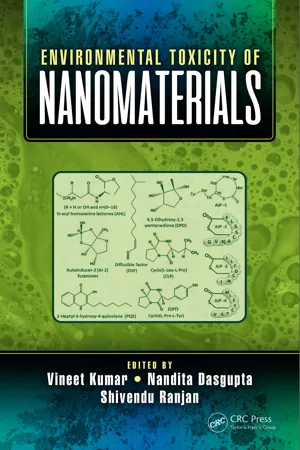
- 523 pages
- English
- ePUB (mobile friendly)
- Available on iOS & Android
Environmental Toxicity of Nanomaterials
About this book
Environmental Toxicity of Nanomaterials focuses on causes and prevention of environmental toxicity induced by various nanomaterials. In sixteen chapters it describes the basic principles, trends, challenges, and future directions of nanoecotoxicity.
The future acceptance of nanomaterials in various industries depends on the impacts of nanomaterials on the environment and ecosystem. This book analyzes the safe utilization of nanotechnology so the tremendous prospect of nanotechnology can be achieved without harming either living beings or the environment.
Environmental Toxicity of Nanomaterials introduces nanoecotoxicity, describes various factors affecting the toxicity of nanomaterials, discusses various factors that can impart nanoecotoxicity, reviews various studies in the area of nanoecotoxicity evaluation, and describes the safety and risk assessment of nanomaterials. In addition, the book discusses strategies for mitigating nanoecotoxicity. Lastly, the authors provide guidelines and protocols for nanotoxicity evaluation and discuss regulations for safety assessment of nanomaterials. In addition to environmental toxicologists, this book is aimed at policy makers, industry personnel, and doctoral and postdoctoral scholars.
Frequently asked questions
- Essential is ideal for learners and professionals who enjoy exploring a wide range of subjects. Access the Essential Library with 800,000+ trusted titles and best-sellers across business, personal growth, and the humanities. Includes unlimited reading time and Standard Read Aloud voice.
- Complete: Perfect for advanced learners and researchers needing full, unrestricted access. Unlock 1.4M+ books across hundreds of subjects, including academic and specialized titles. The Complete Plan also includes advanced features like Premium Read Aloud and Research Assistant.
Please note we cannot support devices running on iOS 13 and Android 7 or earlier. Learn more about using the app.
Information
1Toxic Effects of Nanomaterials on Environment
1.1Introduction
Table of contents
- Cover
- Half Title Page
- Title Page
- Copyright Page
- Contents
- Preface
- Editors
- Contributors
- Chapter 1 Toxic Effects of Nanomaterials on Environment
- Chapter 2 Nanotoxicity: Impact on Health and Environment
- Chapter 3 Nanotoxicological Evaluation in Marine Water Ecosystem: A Detailed Review
- Chapter 4 Interaction of Carbon Nanomaterials with Biological Matrices
- Chapter 5 Interaction of Inorganic Nanoparticles with Biological Matrices
- Chapter 6 Effects of Engineered Nanoparticles on Bacteria
- Chapter 7 Comparative Risk Assessment of Copper Nanoparticles with Their Bulk Counterpart in the Indian Major Carp Labeo rohita
- Chapter 8 Toxic Effects of Nanomaterials to Plants and Beneficial Soil Bacteria
- Chapter 9 Nanotoxicity of Silver Nanoparticles: From Environmental Spill to Effects on Organisms
- Chapter 10 Nanotoxicity on Human and Plant Pathogenic Microbes and Aquatic Organisms
- Chapter 11 Methods of In Vitro and In Vivo Nanotoxicity Evaluation in Plants
- Chapter 12 In Vitro and In Vivo Nanotoxicity Evaluation in Plants
- Chapter 13 Phytochemicals and Their Functionalized Nanoparticles as Quorum Sensing Inhibitor and Chemotherapeutic Agent
- Chapter 14 Nanotoxicological Evaluation in Freshwater Organisms
- Chapter 15 Guidelines and Protocols for Nanotoxicity Evaluation
- Chapter 16 Regulations for Safety Assessment of Nanomaterials
- Index